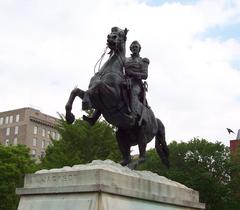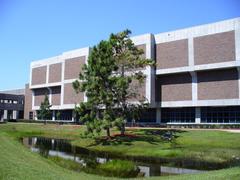
Complete Guide to Imeson Field Visiting Hours, Tickets, and Jacksonville Historical Sites
Date: 03/07/2025
Introduction
Imeson Field stands as a cornerstone of Jacksonville, Florida’s aviation heritage. Established in 1927 and named after aviation advocate Thomas Cole Imeson, the airfield played a pivotal role both in civilian and military aviation for over four decades. While the airport ceased operations in 1968, its legacy persists in the form of the Imeson International Industrial Park and through the stories preserved by local museums and historical societies. This comprehensive guide details Imeson Field’s history, current access, visitor tips, and nearby attractions for a meaningful exploration of Jacksonville’s rich past. For further information, consult resources such as the Jacksonville Aviation Authority, Jacksonville Historical Society, and the Museum of Science & History.
Table of Contents
- Imeson Field: Jacksonville’s Historic Aviation Landmark
- History and Significance
- Visiting Imeson Field: Practical Information
- Cultural Legacy and Photography
- Nearby Historical Attractions
- Frequently Asked Questions (FAQ)
- References and Further Reading
Imeson Field: Jacksonville’s Historic Aviation Landmark
Imeson Field was Jacksonville’s first municipal airport, opening in 1927 and quickly establishing itself as the city’s primary aviation hub. The airport facilitated regional commercial flights and became a strategic military asset during World War II, supporting training and anti-submarine missions as Jacksonville Army Airfield. After its closure in 1968, the site was repurposed, marking Jacksonville’s adaptive urban development and commitment to preserving its aviation roots. Portions of the original runways and taxiways remain visible, serving as silent witnesses to the airfield’s storied past.
History and Significance
Founded as Jacksonville Municipal Airport No. 1, Imeson Field was central to the city’s economic and infrastructural growth, supporting passenger and cargo services and fostering neighborhood expansion. During World War II, the airfield was transformed into a major military installation, hosting training units and anti-submarine patrols, underscoring its critical defense role in the southeastern United States. The postwar era saw Imeson Field usher Jacksonville into the jet age before operations shifted to Jacksonville International Airport in 1968 (Jacksonville Aviation Authority). The site’s conversion into the Imeson International Industrial Park continues to support regional commerce, while remnants of the airport’s layout can still be observed (military-history.fandom.com).
Visiting Imeson Field: Practical Information
Accessibility and Viewing
- Current Use: Imeson Field is now the Imeson International Industrial Park. The property is privately owned and not officially open to the public for tours.
- Public Access: While there is no direct public entry, visitors can view remnants of the former runways and taxiways from public roads, notably along Imeson Park Boulevard near the North Main Street and Busch Drive intersection.
- Visiting Hours: The industrial park operates primarily during standard business hours (Monday–Friday, 8:00 AM–6:00 PM), which are the safest times for a visit.
Tickets and Guided Tours
- Admission: No tickets or admission fees are required, as the area is not a formal tourist site.
- Tours: There are currently no official guided tours of the site. However, local organizations such as the Jacksonville Historical Society and Museum of Science & History occasionally offer programs or presentations about Imeson Field and Jacksonville’s aviation history.
Travel Tips
- Parking: Limited parking is available along public roads. Do not park in private business lots or block industrial traffic.
- Accessibility: The roads are accessible by car; however, there are no dedicated pedestrian paths, and mobility accommodations are limited.
- Safety: Exercise caution around heavy vehicles and industrial activity. Remain on public roads and respect private property boundaries.
- Photography: Photographs may be taken from public roads, but avoid capturing sensitive operations.
Cultural Legacy and Photography
Imeson Field’s legacy endures through surviving infrastructure and its integration into Jacksonville’s urban landscape. Photographers and history enthusiasts can capture images of Imeson Park Boulevard (which overlays the former Runway 30), road grids echoing original runways, and the juxtaposition of historic and modern industrial features. To further appreciate the site’s significance, explore archival images and oral histories available through local museums and the Jacksonville Historical Society.
Nearby Historical Attractions
Enhance your visit by exploring these Jacksonville sites:
- Jacksonville International Airport (JAX): Features periodic aviation exhibits and is located about five miles north of the former Imeson Field (Jacksonville International Airport official site).
- Museum of Science & History (MOSH): Offers rotating exhibits on regional history, including aviation (Museum of Science & History).
- Naval Air Station Jacksonville: Provides public tours and periodic air shows; consult the official site for schedules.
- Jacksonville Historical Society: Maintains archives and offers programs on local history (Jacksonville Historical Society).
Frequently Asked Questions (FAQ)
Q: Is Imeson Field open to the public?
A: The site is not open for public tours but can be viewed from public roads bordering the industrial park.
Q: Are there guided tours or visitor centers?
A: There are no official tours or visitor centers at the site. Local museums and historical societies may offer related programming.
Q: What remains of the original airfield?
A: Imeson Park Boulevard follows the alignment of the former Runway 30, and the road grid within the industrial park reflects the airfield’s original layout.
Q: Are there historical markers on-site?
A: No official markers exist on-site, but extensive historical information is available through local institutions.
Q: What nearby attractions can I visit?
A: Jacksonville International Airport, the Museum of Science & History, and the Jacksonville Historical Society are all excellent options for further exploration.
References and Further Reading
- Jacksonville Aviation Authority
- Jacksonville International Airport official site
- Museum of Science & History
- Jacksonville Historical Society
- Imeson Field on military-history.fandom.com
- Imeson Field on everything.explained.today
- Jacksonville Transportation Authority
- JaxFacts Visitor Guide
- Jacksonville Events Calendar
- Tourist Places Guide
Summary and Final Tips
Although Imeson Field is no longer an operational airport, its historical influence on Jacksonville’s growth and aviation legacy is unmistakable. Today, visitors can trace the site’s past through visible runway alignments, archival maps, and the surrounding industrial landscape. While direct public access is limited, a self-guided visit from public roads offers a unique window into Jacksonville’s pioneering aviation era. For a deeper experience, explore nearby museums and institutions, and stay connected with local historical organizations and tools like the Audiala app for self-guided tours and updates. Embracing Imeson Field’s story provides a meaningful perspective on the city’s resilience and evolution as a transportation and economic hub.
Images and Maps:
- Include historic photos of Imeson Field’s terminal and runways (with alt text: “Imeson Field historic terminal building”).
- Provide current aerial views highlighting runway remnants.
- Feature maps overlaying the original airfield layout with the modern industrial park.









